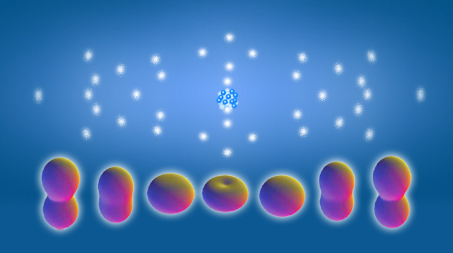An international team of scientists led by research groups from the Max Planck Institute in Germany, and the US Department of Energy and the University of California, used extremely short flashes of laser radiation to directly observe the movement of the outer electrons in an atom, for the first time ever

An international team of scientists led by research groups from the Max Planck Institute in Germany, and from the US Department of Energy and the University of California, used extremely short flashes of laser radiation to directly observe the movement of the outer electrons in the atom, for the first time ever.
Using a process known as "attosecond absorption spectroscopy" (attosecond = 10^-18 second), the researchers were able to measure with great precision the time intervals between the fluctuations of the quantum states of the valence electrons that were created at the same time. These vibrations are responsible for the movement of the electron.
"Using a simple system of krypton atoms we have demonstrated, for the first time ever, that it is possible to measure transient absorption dynamics by atto-second pulses," said Stephen Leone, professor of chemistry and physics at the University of California, Berkeley. "Thanks to this experiment, we were able to reveal details about a type of electron movement known as "coherent superposition" which is capable of controlling the properties of many systems."
The scientist cites a recent study conducted in the group of researcher Graham Fleming, also from the University of Berkeley, on the crucial and important role of coherent systems, for example in photosynthesis, noting that: "The method for testing coherent dynamics developed by our team has never been available to researchers. It is indeed general and can be applied to problems of electronic dynamics of attoseconds in the fields of physics and chemistry of liquids, solids, biological systems and more."
The demonstration of the method begins with the ionization of krypton atoms to remove one or more of the outer electrons using pulses of laser radiation in the near infrared range, usually measured on a time scale of femtoseconds (femtosecond = 10-15 seconds). Then, by using much shorter pulses of extreme ultraviolet light radiation on a time scale of 100 attoseconds, they were able to precisely measure the effects of the valence electrons. The research findings were published in the prestigious scientific journal Nature.
Valence electrons (electrons in the outer shell of the atom that participate in the formation of a chemical bond) are responsible for the ability of the atoms to bind to each other to obtain particles or crystal structures, and for the timing of their breaking and re-forming of bonds during chemical reactions. Changes in molecular structures occur on a time scale of many femtoseconds and are often observed using femtosecond spectroscopy, which these researchers pioneered.

4 תגובות
Ami - 10 times is a lot just like you said, it's one order of magnitude bigger as they usually say.
Your math is just fine your understanding of what order of magnitude means is lacking.
According to the calculation: 2x=c*T where x is the distance from the measuring device, c the speed of light, T the cycle time of the laser pulses, the distance of about 1.5 angstroms from the measuring device to the electrons comes out, that is 1.5 times the size of an atom!
Sorry, correcting the hyphens from the word "speed" to the word "short"
The meaning remains the same.
Isn't the difference between a femto second and a hundred atto seconds a total of ten times? One order of magnitude? This means that the UV rays are not "much faster". They are a little faster. one in ten
Or maybe I didn't quite understand the simple calculation.
Greetings friends,
Ami Bachar